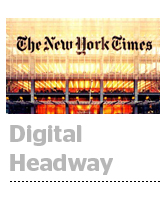 The New York Times reported relatively modest fourth-quarter and full-year earnings on Tuesday, but chief Mark Thompson hailed it as “the most encouraging year-over-year trend” for total advertising revenue since 2005. To that end, he touted strong growth in digital advertising, sponsored content and subscription-based revenue.
The New York Times reported relatively modest fourth-quarter and full-year earnings on Tuesday, but chief Mark Thompson hailed it as “the most encouraging year-over-year trend” for total advertising revenue since 2005. To that end, he touted strong growth in digital advertising, sponsored content and subscription-based revenue.
“We were particularly pleased with the strong growth in digital advertising, boosted by the introduction of Paid Posts, our native advertising solution, as well as rapid growth in ad sales associated with video and mobile,” Thompson said in a press release. “We delivered digital ad growth for all four quarters, highlighted by double-digit strength in the second half of the year, including a 19% gain in the fourth quarter.”
Q4 revenue hit $444.7 million, a tiny 0.2% bump from 2013’s Q4 revenue of $443.9 million. But digital ad revenue grew a healthy 19.3% in 2014’s fourth quarter and, at $63.2 million, accounted for 30.5% of the publisher’s total ad revenue. That’s a significant jump from 2013’s Q4 digital ad revenue of $53 million. Print ad revenue during the quarter suffered by comparison, dipping 9.2%.
For the year in full, digital advertising revenue grew 11.9% to hit $182.2 million, compared to $162.9 million in 2013. Meanwhile print advertising in 2014 decreased by 4.7%.
Operating profit in 2014’s Q4 hit $62.4 million, down from $68.9 million in Q4 2013, which the publisher attributed to staff reductions and retirement costs coupled with meager overall revenue growth. For the full year, operating profit hit $91.9 million, down drastically from $156.1 million in 2013.
Though the publisher saw substantial digital ad revenue growth, investment in the sector weakened overall operating profit.
“The reduction in operating profit for the year was due to our strategic investments in digital and severance costs associated with our long-term focus on cost reduction,” Thompson explained. “We intend to continue to invest in digital growth but will also bear down on costs to defend our profitability.”
“Despite print decline in both our advertising and circulation revenue streams in the fourth quarter, the momentum in our digital business led to revenues that were up slightly overall,” said Times CFO James Follo during a call with investors. “We’re begging to see the benefits of our strategic initiatives in transforming our organization. Digital advertising continues to see a boost from paid posts as well as mobile and video.”
The Times is working with 40 advertisers through its sponsored content arm, T Brand Studio, running about 50 campaigns for a broad rage of advertisers, including luxury brands, automotive and financial services, and expects to further diversify its advertiser base across verticals in 2015.
But with growing interest in native content, investors wanted to know about the distribution of inventory and any changes to pricing that may cause.
Thompson explained that paid posts are additive to existing digital advertising inventory, and said the company expects to more than double its capacity to produce sponsored content through T Brand Studio.
“Paid posts are self-generative of inventory, so they’re creating new inventory as they go,” Times EVP of Advertising Meredith Kopit Levien explained during the call. “In general, we have not seen tremendous pressure on CMPs. In both print and digital, our product is significantly differentiated that we should be able to maintain that CPM.”
In terms of the ad revenue breakdown between mobile, video and paid posts, Levien said mobile accounted for slightly more than 10% of the publisher’s digital ad revenue for the year, and video was a “smaller number” but had a similar growth trajectory. Paid posts, she added, was inside of 10% of the overall business.
“We expect these to be three of the four or five things that will keep driving digital growth in 2015,” she said.
Looking forward, the publisher expects total ad revenue for 2015’s first quarter to decrease in the mid-single digits compared to 2014’s first quarter.
“In 2015, we will remain focused on using our unique journalism and brand to broaden and deepen our audience and to monetize that audience more effectively through innovation in both digital and print,” Thompson said. In the near term, the Times will focus on the relaunch of its magazine, as well as vetting new talent in the marketing, digital product and technology departments.












